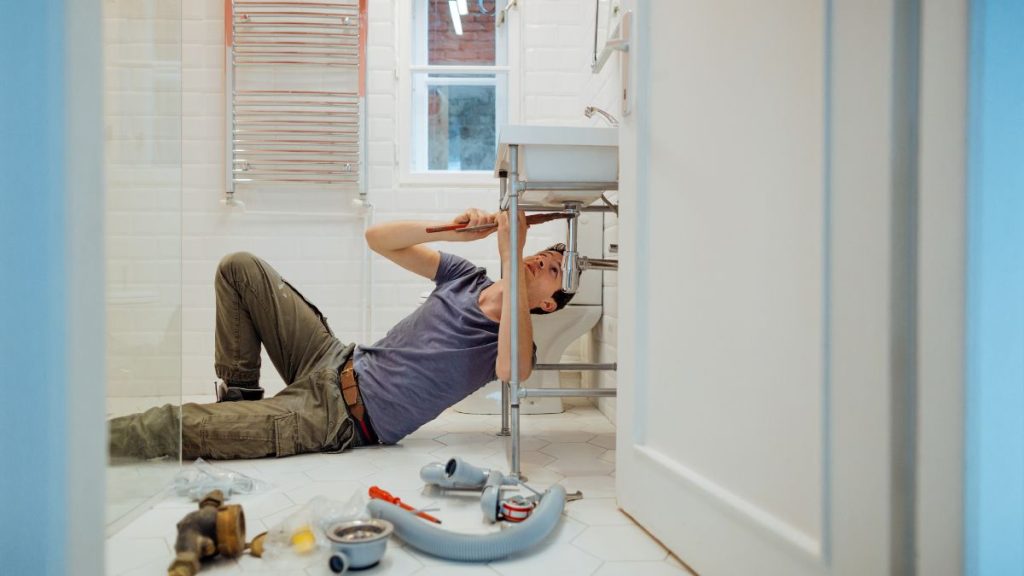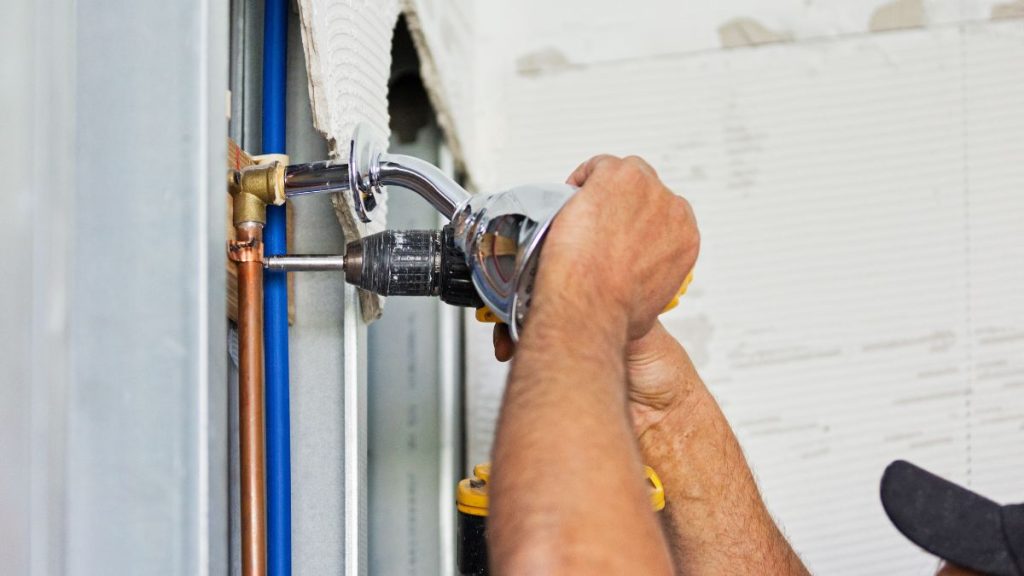Have you ever thought about how your bathroom plumbing could be more adaptable and easier to manage? If so, raised floor bathroom plumbing might be the solution you’re looking for.
Imagine a system where your plumbing is neatly tucked away beneath your floor, giving you more flexibility and easier access for repairs or renovations. That’s the essence of raised floor bathroom plumbing—a modern approach that’s gaining popularity in home remodeling projects.
Everything you need to know about raised floor bathroom plumbing. From understanding how it works to the benefits it offers and how to install it properly, we’ve got you covered.
Whether you’re considering this for a new build or a bathroom remodel, this guide will help you make informed decisions and avoid common pitfalls.
Know the Raised Floor Plumbing Systems
How Raised Floor Plumbing Works
So, what exactly is raised floor bathroom plumbing, and how does it differ from traditional systems? At its core, raised floor plumbing involves elevating the floor of your bathroom to create a space underneath.
This elevated space houses the plumbing pipes, drains, and vents. The raised floor system is designed to be both functional and aesthetically pleasing, allowing for easier access to your plumbing while maintaining a clean look in your bathroom.
One of the main differences between raised floor plumbing and traditional plumbing is the accessibility it offers. In a traditional setup, plumbing is often installed within walls or beneath a solid floor, which can make repairs and modifications challenging.
With raised floor plumbing, you have a convenient access panel or removable floor tiles that make it much simpler to get to your pipes when needed.
Components of a Raised Floor Plumbing System
Understanding the components of a raised floor plumbing system can help you appreciate how it all fits together:
- Pipes and Drains: These are the core elements of your plumbing system, transporting water to and from various fixtures. In a raised floor system, these pipes are routed underneath the elevated floor, making them easy to access if adjustments or repairs are needed.
- Supports and Flooring Materials: The raised floor is supported by a framework of adjustable pedestals or supports, which ensure stability and allow for a uniform height across the room. Flooring materials, such as tiles or laminate, are then installed over this framework to create a finished surface.
- Venting and Access Panels: Proper venting is crucial for the functionality of any plumbing system. Raised floor systems often include access panels or removable sections of flooring that provide entry points for maintenance and inspections. These panels ensure that you can easily reach all parts of your plumbing without having to dismantle large sections of your bathroom.
Raised floor bathroom plumbing not only simplifies the process of managing your plumbing but also offers flexibility in design and maintenance. As you consider this option for your bathroom, understanding these components will help you make more informed decisions and ensure a successful installation.
Benefits of Raised Floor Bathroom Plumbing

Opting for raised floor bathroom plumbing can offer several advantages, making it a compelling choice for many homeowners. Here’s a closer look at the key benefits:
Improved Accessibility
One of the standout benefits of raised floor bathroom plumbing is the easy access it provides. With your plumbing housed beneath an elevated floor, you can quickly reach pipes and drains through access panels.
This means that if a leak springs or a pipe needs adjustment, you won’t have to rip up flooring or cut into walls. It’s like having a built-in maintenance access without the mess.
Enhanced Design Flexibility
Raised floor systems offer remarkable flexibility in bathroom design. Since plumbing is concealed beneath the floor, you’re free to experiment with different layouts and configurations.
Want to move your sink or add a new fixture? With raised floor plumbing, rerouting pipes and drains is much simpler compared to traditional systems. This flexibility is especially useful in renovation projects where you might want to reconfigure your space.
Cost Efficiency in Certain Scenarios
While raised floor systems can have a higher initial installation cost, they can save you money in the long run. For older homes with concrete slabs, cutting through the floor for plumbing can be expensive and labor-intensive.
Raised floor plumbing can be a cost-effective solution in such cases, as it avoids the need for extensive concrete work. Additionally, the ease of access can reduce long-term maintenance costs.
Easier Installation for Renovations
If you’re remodeling an existing bathroom, raised floor plumbing can simplify the installation process. Instead of dealing with existing plumbing that may be difficult to modify, you can install a new raised floor system that accommodates your new layout.
This can streamline your renovation and reduce the time and effort needed to complete the project.
Challenges and Considerations

While raised floor bathroom plumbing offers many benefits, it’s important to consider the potential challenges and implications before diving in.
Space Limitations
One of the primary challenges of raised floor plumbing is the reduction in ceiling height. Elevating the floor means you lose some vertical space, which can be a concern in bathrooms with already limited headroom. Before installing a raised floor system, measure the height carefully to ensure it won’t negatively impact the usability of your bathroom.
Weight and Structural Support
Raised floor systems add additional weight to your bathroom, which requires adequate structural support. The subfloor must be capable of supporting the raised floor system without sagging or instability. This might involve reinforcing existing structures or making adjustments to ensure that the floor can handle the extra load.
Cost Implications
The cost of installing a raised floor plumbing system can be higher compared to traditional plumbing methods. This is due to the materials and labor required to build and install the raised floor and its components. However, as mentioned earlier, the initial costs can be offset by the long-term savings on maintenance and repairs.
Moisture and Waterproofing Concerns
Proper moisture management is crucial in any bathroom, and raised floor systems are no exception. It’s essential to ensure that the space beneath the floor is well-sealed and waterproofed to prevent water damage and mold growth. Regular inspections and maintenance of the waterproofing layers are necessary to keep the system in good condition.
Considering these challenges will help you make a well-informed decision about whether raised floor bathroom plumbing is the right choice for your home. Balancing the benefits with the potential hurdles can lead to a successful and satisfying installation.
Installation Process: Step-by-Step Guide
Installing a raised floor bathroom plumbing system involves several key steps to ensure everything is set up correctly and functions efficiently. Here’s a step-by-step guide to help you through the process:
Planning and Designing Your Raised Floor System
Assess Space and Layout:
Start by measuring your bathroom and planning the layout. Consider where your fixtures (sink, toilet, shower) will be placed and how the plumbing will be routed underneath the floor. Create a detailed floor plan to guide the installation.
Select Materials and Components
Choose the materials for your raised floor system, including the supports (pedestals), flooring (tiles, laminate), and plumbing components (pipes, drains). Ensure that all materials are compatible and meet local building codes.
Building the Raised Floor Framework
Install Supports
Set up the pedestals or supports according to your floor plan. These supports will hold the raised floor in place and provide the necessary space for plumbing. Make sure they are level and evenly spaced.
Lay the Subfloor
Place the subfloor panels on top of the supports. The subfloor creates a stable base for the final flooring and allows access to the plumbing below. Secure the panels according to the manufacturer’s instructions.
Laying Out and Installing Plumbing
Install Plumbing Pipes and Drains
Route your plumbing pipes and drains through the space beneath the raised floor. Connect them to the existing plumbing system as needed. Ensure that all connections are secure and leak-free.
Add Venting
Install any necessary vents to ensure proper drainage and air flow. Venting helps prevent clogs and maintains the efficiency of your plumbing system.
Sealing and Waterproofing
Apply Moisture Barriers
Install moisture barriers beneath the floor to protect against water damage. Ensure that the barriers are properly sealed and cover all areas where moisture could potentially cause issues.
Seal Access Points
Make sure that access panels and any openings are properly sealed to prevent water from getting into the space beneath the floor. Use waterproof sealants as needed.
Final Flooring Installation
Install the Final Floor Surface
Lay down the final flooring material, such as tiles or laminate, on top of the subfloor. Follow the manufacturer’s instructions for installation and ensure that the flooring is securely attached.
Finishing Touches
Trim any excess material, install baseboards, and make sure all access panels are in place. Your raised floor system should now be complete and ready for use.
Inspection and Testing
Conduct a Thorough Inspection
Check all plumbing connections, seals, and flooring to ensure everything is properly installed and functioning. Look for any signs of leaks or issues.
Test the System
Run water through the system to test for leaks and ensure that all drains are working correctly. Address any issues before using the bathroom.
Maintenance Tips for Raised Floor Bathroom Plumbing

Maintaining a raised floor bathroom plumbing system is essential to ensure its longevity and efficiency. Here are some practical maintenance tips to keep your system in top shape:
Regular Inspections
Check for Leaks
Periodically inspect the space beneath the raised floor for any signs of leaks. Look for water stains, dampness, or other indicators that may suggest a problem.
Inspect Plumbing Connections
Examine the plumbing pipes and connections for any signs of wear or damage. Tighten any loose fittings and replace any corroded parts as needed.
Access Panel Management
Keep Access Points Clear
Ensure that access panels and removable sections of the floor are kept clear and easily accessible. This will make it simpler to perform inspections and repairs.
Regular Cleaning
Clean access panels and surrounding areas to prevent dust and debris from accumulating. This will help maintain the integrity of the system and ensure smooth operation.
Preventative Measures
Use Water-Resistant Materials
Opt for water-resistant materials in areas prone to moisture to reduce the risk of water damage. This includes using waterproof sealants and moisture barriers.
Monitor Humidity Levels
Keep an eye on the humidity levels in your bathroom to prevent mold and mildew growth. Use dehumidifiers or exhaust fans if necessary.
These maintenance tips, you can keep your raised floor bathroom plumbing system functioning effectively and avoid potential issues down the line. Regular care and attention will ensure that your system remains a valuable asset in your home.
Cost Considerations
When planning a raised floor bathroom plumbing system, understanding the cost implications is crucial. Here’s a breakdown to help you navigate the financial aspects:
Initial Installation Costs
Materials
The cost of materials for a raised floor system includes supports, subfloor panels, final flooring, and plumbing components. Prices can vary based on the quality and type of materials chosen. For instance, high-quality tiles or laminate and premium plumbing fixtures can increase the overall cost.
Labor
Installation costs also encompass labor. Professional installation is recommended for raised floor systems to ensure everything is set up correctly and meets building codes. Labor costs can vary depending on your location and the complexity of the installation.
Additional Structural Work
If your existing bathroom requires structural modifications to support the raised floor, such as reinforcing the subfloor, this will add to the overall expense. It’s important to factor in these potential costs when budgeting.
Long-Term Savings
Reduced Maintenance Costs
While the initial investment may be higher, the ease of access for repairs can result in lower long-term maintenance costs. Regular upkeep is simpler and less costly when you can quickly reach plumbing components without major disruptions.
Avoiding Concrete Work
In older homes with concrete floors, raised floor plumbing can be more cost-effective than cutting through concrete for traditional plumbing. This can save on both labor and materials related to extensive floor modifications.
Potential Energy Efficiency
Raised floor systems can sometimes offer better insulation options, potentially leading to energy savings. Insulating the space beneath the floor can help maintain consistent temperatures and reduce energy bills.
Potential Cost Variations
Location
Installation costs can vary significantly based on your geographical location. Urban areas or regions with a high cost of living may see higher labor and material prices compared to more rural areas.
Bathroom Size and Complexity
Larger bathrooms or those with complex layouts may incur higher costs due to the increased amount of materials and labor required. Custom designs and additional features will also influence the final price.
Permits and Codes
Ensure you account for any necessary permits and adherence to local building codes. These requirements can impact the overall cost and must be factored into your budget.
Common Mistakes to Avoid

When installing a raised floor bathroom plumbing system, avoiding common pitfalls can save time, money, and hassle. Here are some mistakes to watch out for:
Underestimating Structural Support Needs
Not Reinforcing the Subfloor
One of the biggest mistakes is failing to ensure that the existing structure can support the added weight of a raised floor system. Inadequate support can lead to sagging or instability, so it’s essential to assess and reinforce the subfloor as needed.
Ignoring Load-Bearing Requirements
Be mindful of load-bearing requirements and ensure that the raised floor system’s supports are properly installed and spaced. This will prevent structural issues and maintain the integrity of the system.
Ignoring Waterproofing
Inadequate Moisture Barriers
Failing to install proper moisture barriers beneath the floor can lead to water damage and mold growth. Ensure that all areas prone to moisture are adequately sealed and protected.
Overlooking Sealing of Access Points
Access panels and other openings should be sealed effectively to prevent water from seeping into the space beneath the floor. Regularly check and maintain these seals to avoid potential issues.
Poor Planning and Design
Inflexible Layouts
Designing a raised floor system without considering future changes or repairs can be problematic. Plan for flexible layouts that allow for easy adjustments and access to plumbing components.
Neglecting Ventilation Needs
Proper venting is crucial for a functional plumbing system. Failing to include adequate vents can lead to drainage issues and reduced efficiency. Make sure to incorporate proper ventilation into your design.
Being aware of these cost considerations and common mistakes, you can make more informed decisions and ensure a successful raised floor bathroom plumbing installation. Proper planning and execution will help you avoid pitfalls and enjoy the benefits of a well-designed plumbing system.
Raised Floor Plumbing in Different Bathroom Scenarios

Raised floor bathroom plumbing can be a versatile solution for various bathroom settings. Here’s how this system can be adapted to different scenarios:
New Construction
Optimized Design Flexibility
In new construction, raised floor plumbing offers unparalleled design flexibility. You can plan the layout of your plumbing system from the start, allowing you to optimize the placement of fixtures and easily incorporate future changes.
Seamless Integration
During new builds, raised floor plumbing can be seamlessly integrated into the overall design. This approach allows for a more cohesive installation, ensuring that plumbing and flooring systems work together efficiently from the beginning.
Future-Proofing
Installing a raised floor system in new construction can future-proof your bathroom. The accessibility of the plumbing system makes it easier to accommodate any future modifications or upgrades, enhancing the longevity of your investment.
Bathroom Renovations
Simplified Retrofits
For bathrooms undergoing renovations, raised floor plumbing can simplify the process of updating or relocating plumbing fixtures. Instead of dealing with existing plumbing constraints, you can install a raised floor system that aligns with your new design vision.
Enhanced Accessibility
Renovations often involve updating old or problematic plumbing. Raised floor systems provide easy access to existing pipes and drains, making it easier to perform repairs or upgrades without extensive demolition.
Cost vs. Benefit Analysis
While the installation of a raised floor system in a renovation may come with higher initial costs, the long-term benefits of easier maintenance and flexibility can make it a worthwhile investment. Assess the potential cost savings and design benefits before deciding.
Small Bathrooms
Space Optimization
Raised floor plumbing can be particularly advantageous in small bathrooms where space is at a premium. By elevating the floor, you can create additional storage or conceal plumbing components that would otherwise take up valuable space.
Improved Design Choices
In a compact bathroom, raised floor systems can enhance design options by allowing for more creative layouts and fixture placements. This flexibility helps make the most of limited space and improve the overall functionality of the bathroom.
Considerations for Height
When installing a raised floor system in a small bathroom, be mindful of the reduced ceiling height. Ensure that the elevation of the floor does not negatively impact the usability or comfort of the space.
Bathrooms with Existing Concrete Slabs
Cost-Effective Solution
For bathrooms with existing concrete slabs, raised floor plumbing offers a cost-effective alternative to cutting through the concrete. This approach avoids the extensive labor and expense associated with modifying a concrete floor for plumbing.
Minimized Disruption
Installing a raised floor system over a concrete slab minimizes disruption to the existing structure. It allows for plumbing installation without the need for invasive alterations to the concrete, making the process cleaner and less time-consuming.
Considerations for Insulation
When adding a raised floor system over a concrete slab, consider incorporating insulation beneath the raised floor to improve comfort and energy efficiency. Proper insulation can help regulate temperature and reduce noise.
High-Humidity or Moisture-Prone Areas
Enhanced Moisture Management
In bathrooms with high humidity or moisture levels, raised floor plumbing systems can be particularly beneficial. The elevated floor allows for better moisture management and easier maintenance of waterproofing measures.
Preventing Water Damage
Raised floor systems can help prevent water damage by keeping plumbing components elevated and protected from potential flooding or leaks. Ensure that proper waterproofing and drainage solutions are in place to complement the raised floor system.
Regular Maintenance
For bathrooms in moisture-prone areas, regular maintenance of the raised floor system is essential. Periodically check for any signs of moisture buildup or damage and address issues promptly to maintain the system’s integrity.
Adapting raised floor plumbing to various bathroom scenarios, you can optimize its benefits and ensure that it meets the specific needs of your space. Whether you’re dealing with a new construction, renovation, or a challenging bathroom layout, raised floor plumbing offers versatile solutions that enhance functionality and design flexibility.
Conclusion
Raised floor bathroom plumbing presents a compelling solution for both new builds and renovations, offering a range of benefits that enhance functionality and design flexibility. By elevating the floor, this system simplifies plumbing access, optimizes space usage, and can even contribute to better moisture management.
Key Points Recap:
- Benefits: A raised floor system provides easy access for repairs and updates, allows for creative design solutions, and helps manage moisture more effectively. It’s especially useful in situations involving concrete slabs or high-humidity environments.
- Challenges: Despite its advantages, raised floor plumbing can come with challenges such as increased installation costs and the need for additional structural support. Careful planning and consideration of these factors are essential for a successful outcome.
- Installation and Maintenance: Proper installation requires careful planning and attention to detail, including structural reinforcement and sealing. Regular maintenance is crucial for ensuring the system remains in good condition and performs effectively over time.
- Cost Considerations: While the initial investment might be higher, the long-term benefits of easier maintenance and enhanced design flexibility often outweigh the costs. Assessing the overall value of raised floor plumbing can help in making an informed decision.
Raised floor bathroom plumbing is a versatile and practical choice that can enhance the functionality and aesthetics of your bathroom. By addressing potential challenges and understanding the benefits and costs, you can make the most of this innovative solution.
Whether you’re building from scratch or renovating, a raised floor system can offer lasting benefits and improve your overall bathroom experience.



